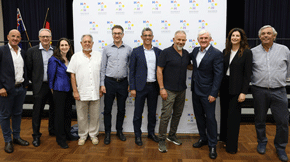New Herod exhibition
The Israel Museum, Jerusalem, will premiere the world’s first exhibition on the life and legacy of Herod the Great, one of the most influential – and controversial – figures in ancient Roman and Jewish history.

King Herod’s sarcophagus (?) fashioned in reddish limestone and decorated with rosettes and palmettes
Photo © the Israel Museum, Jerusalem / by Meidad Suchowolski
On view from February 12, 2013, through October 5, 2013, the landmark exhibition Herod the Great: The King’s Final Journey will present approximately 250 archaeological finds from the king’s recently discovered tomb at Herodium, as well as from Jericho and other related sites, to shed new light on the political, architectural, and aesthetic impact of Herod’s reign from 37 to 4 BCE. Among the objects on view—all of which have undergone extensive restoration at the Israel Museum for exhibition display purposes—will be three sarcophagi from Herod’s tomb and restored frescoes from Herodium, his private bath from the palace at Cypros; never-before-seen carved stone elements from the Temple Mount; and an imperial marble basin thought to be a gift from Augustus.
Lionized as the “the greatest builder of human history,” King Herod was also demonized for his uncertain ethnic and religious pedigree, controversial political alliances, the execution of his wife and three of his children, and erroneous association with the New Testament narrative of the “Massacre of the Innocents” in Bethlehem. Herod the Great: The King’s Final Journey seeks to provide a better understanding of this ancient figure through the monumental architecture he created and the art and objects with which he surrounded himself. The exhibition will examine Herod’s remarkable building projects, complex diplomatic relations with the Roman emperors and nobility, and dramatic funeral procession from Jericho to the mausoleum he constructed for himself in Herodium. A striking reconstruction of the burial chamber of the mausoleum is a centerpiece of the exhibition.
In 2007, after a 40-year search, renowned archaeologist Professor Ehud Netzer of the Hebrew University of Jerusalem discovered the ruler’s tomb at Herodium on the edge of the Judean Desert. The site included a fortress palace and a leisure complex with gardens, large pools, decorated bathhouses, and a theatre with a royal box. In his final years, Herod reconfigured the architecture of the complex to prepare the setting for his burial procession and site, and constructed a magnificent mausoleum facing Jerusalem. The Museum’s exhibition is dedicated to the memory of Professor Netzer, who died in 2010 at the site of his seminal discovery.
“Professor Ehud Netzer capped his decades-long excavation of Herodium with his discovery of King Herod’s tomb in 2007, and over the past five years, archaeologists excavating the site have made remarkable discoveries that have deepened our appreciation of Professor Netzer’s remarkable achievement and enriched our understanding of Herod, his reign, and his role in the history of the region,” said James S. Snyder, Anne and Jerome Fisher Director. “We are proud of the extensive restoration work that our conservation staff has been able to complete and thrilled to present these important finds to the public for the first time in an exhibition that will illuminate a pivotal period in the history of the Land of Israel.”
Herod the Great: The King’s Final Journey is organized by the Israel Museum and curated by David Mevorah, Curator of Hellenistic, Roman, and Byzantine Periods, and Dr. Silvia Rozenberg, Rodney E. Soher Senior Curator of Classical Archeology. The exhibition will be accompanied by a comprehensive 250-page catalogue, published by the Israel Museum, featuring the first publication of the tomb complex and other discoveries from Herodium. The catalogue will also include scholarly articles on Herod’s life and the legacy of Herodian architecture, written by Professor Netzer before his death in 2010, and by other leading experts in the field.
The Israel Museum is the largest cultural institution in the State of Israel and is ranked among the leading art and archaeology museums in the world. Founded in 1965, the Museum houses encyclopedic collections ranging from prehistory through contemporary art and includes the most extensive holdings of Biblical and Holy Land archaeology in the world, among them the Dead Sea Scrolls. In just over 45 years, the Museum has built a far-ranging collection of nearly 500,000 objects through an unparalleled legacy of gifts and support from its circle of patrons worldwide. In 2010, the Museum completed a comprehensive renewal of its campus led by James Carpenter Design Associates, New York, and Efrat-Kowalsky Architects, Tel Aviv, including the creation of new galleries, orientation facilities, and public spaces, and the complete reinstallation of its encyclopedic collections. The Museum also organizes and presents programming at its off-site locations in Jerusalem at the Rockefeller Archaeological Museum, where it presents archaeological artifacts from the Land of Israel, and at its historic Ticho House in downtown Jerusalem, a venue for exhibitions of contemporary Israeli art.










